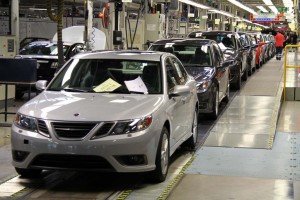Still struggling to re-start the assembly plant that has been idled for most of the last three months, Swedish automaker Saab has announced plans to add three new models to its line-up.
The maker has been lining up a coterie of partners, in recent weeks, raising funds to overcome its ongoing cash problems. A $40 million deal to sell and then lease back its Trollhattan plant, along with a $36 million bridge loan, could resolve its most immediate problems, allowing production to resume sometime in the coming days.
But even before the Trollhattan plant starts rolling again, Victor Muller, Chairman of Saab and its parent, Swedish Automobile, announced three new products that are either a much-needed plan for the future, or little more than wishful thinking.
“We will now be able to develop a small entry-level Saab, a car that has long been on the top of our wish list,” says a statement from Muller, who noted Saab also wants to add two models bigger than its current offerings.
The maker’s problems date back well before General Motors sold off Saab in early 2010. After years of failing to meet its earnings targets, GM had already shut down the Trollhattan plant before Muller’s last-minute purchase was completed. That resulted in a sales shortfall that, in turn, left Saab unable to pay its suppliers this year.
In March, a number of key parts vendors decided to boycott the Swedish automaker forcing it to scramble for new sources of cash. It eventually inked a series of alliances with several Chinese companies, including that country’s largest automotive retailer, Pang Da, and the ambitious Chinese carmaker, Zhejiang Youngman Lotus Automobile.
But while those deals were wending their way through the regulatory approval process, Saab’s financial situation continued to worsen, the maker late last month advising workers to go home – unpaid.
Now, Saab has two more backers, including a Swedish commercial real estate firm that has agreed to purchase the Trollhattan plant and other assets for $40 million, leasing them back to the maker. And a $36 million, six-month bridge loan is expected to provide the additional short-term funding needed to pay both workers and suppliers.
When the Trollhattan plant will re-open is uncertain, though Saab is clearly aiming to move fast as it has few other sources of income until that happens. (Production has continued at a GM plant in Mexico producing the Swedish maker’s new 9-4X crossover utility vehicle, but sales are so far modest, many buyers reluctant to commit to Saab, analysts suggest, while the maker’s future remains uncertain.)
But with the company insisting Trollhattan will re-open soon, Saab is already looking to the future. And at the top of its priority list is a model that is expected to be designated the 9-1. According to reports out of China, it would be one of three new offerings produced with the help of Youngman. It is expected to be developed with the help of Youngman but would adopt a retro design harkening back to some of Saab’s early – and quirkiest – offerings.
Meanwhile, Saab also intends to add two higher-end models, likely to be dubbed the 9-6 and 9-7, that would take aim at the larger end of the luxury segment. They would be particularly targeted to the Chinese market, where entrepreneurs, business executives and senior government officials look for chauffeur-driven models withlarge, well-equipped rear seats.
The timeframe for developing the new models has yet to be announced.
While the leaseback deal finally won the approval of the European Investment Bank, the alliance with Pang Da and Youngman is still waiting authorization from officials in both China and Europe. If approved, Saab would get another $356 million in cash, but the two Chinese companies would assume a combined 51% stake in the Swedish maker.

